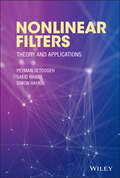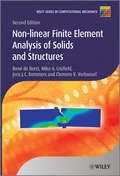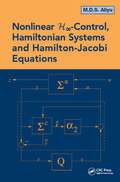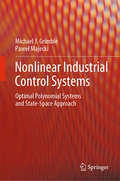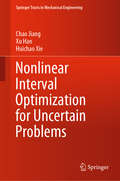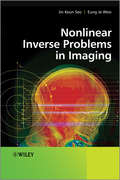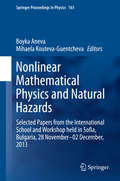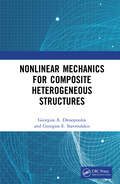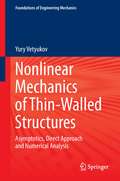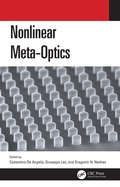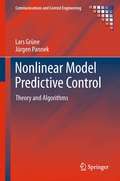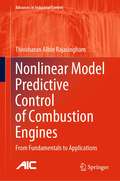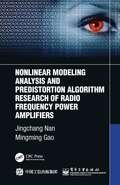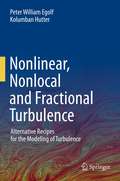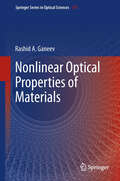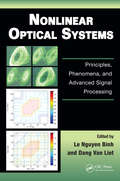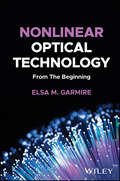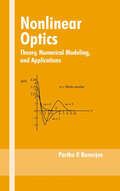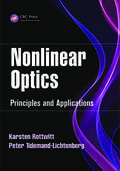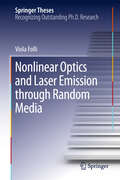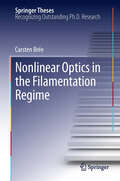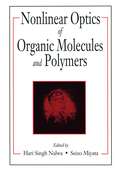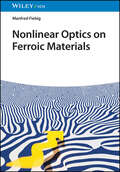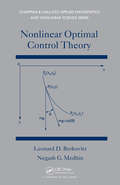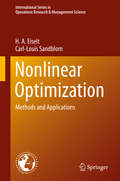- Table View
- List View
Nonlinear Filters: Theory and Applications
by Peyman Setoodeh Saeid Habibi Simon HaykinNONLINEAR FILTERS Discover the utility of using deep learning and (deep) reinforcement learning in deriving filtering algorithms with this insightful and powerful new resource Nonlinear Filters: Theory and Applications delivers an insightful view on state and parameter estimation by merging ideas from control theory, statistical signal processing, and machine learning. Taking an algorithmic approach, the book covers both classic and machine learningbased filtering algorithms. Readers of Nonlinear Filters will greatly benefit from the wide spectrum of presented topics including stability, robustness, computability, and algorithmic sufficiency. Readers will also enjoy: Organization that allows the book to act as a stand-alone, self-contained reference A thorough exploration of the notion of observability, nonlinear observers, and the theory of optimal nonlinear filtering that bridges the gap between different science and engineering disciplines A profound account of Bayesian filters including Kalman filter and its variants as well as particle filter A rigorous derivation of the smooth variable structure filter as a predictor-corrector estimator formulated based on a stability theorem, used to confine the estimated states within a neighborhood of their true values A concise tutorial on deep learning and reinforcement learning A detailed expectation of the expectation maximization algorithm and its machine learning-based variants, used for joint state and parameter estimation Guidelines for constructing nonparametric Bayesian models from parametric ones Perfect for researchers, professors, and graduate students in engineering, computer science, applied mathematics, and artificial intelligence, Nonlinear Filters: Theory and Applications will also earn a place in the libraries of those studying or practicing in fields involving pandemic diseases, cybersecurity, information fusion, augmented reality, autonomous driving, urban traffic network, navigation and tracking, robotics, power systems, hybrid technologies, and finance.
Nonlinear Finite Element Analysis of Solids and Structures
by Mike A. Crisfield Joris J. Remmers Clemens V. Verhoosel René De BorstBuilt upon the two original books by Mike Crisfield and their own lecture notes, renowned scientist René de Borst and his team offer a thoroughly updated yet condensed edition that retains and builds upon the excellent reputation and appeal amongst students and engineers alike for which Crisfield's first edition is acclaimed.Together with numerous additions and updates, the new authors have retained the core content of the original publication, while bringing an improved focus on new developments and ideas. This edition offers the latest insights in non-linear finite element technology, including non-linear solution strategies, computational plasticity, damage mechanics, time-dependent effects, hyperelasticity and large-strain elasto-plasticity.The authors' integrated and consistent style and unrivalled engineering approach assures this book's unique position within the computational mechanics literature.Key features:Combines the two previous volumes into one heavily revised text with obsolete material removed, an improved layout and updated references and notationsExtensive new material on more recent developments in computational mechanicsEasily readable, engineering oriented, with no more details in the main text than necessary to understand the concepts.Pseudo-code throughout makes the link between theory and algorithms, and the actual implementation.Accompanied by a website (www.wiley.com/go/deborst) with a Python code, based on the pseudo-code within the book and suitable for solving small-size problems. Non-linear Finite Element Analysis of Solids and Structures, 2nd Edition is an essential reference for practising engineers and researchers that can also be used as a text for undergraduate and graduate students within computational mechanics.
Nonlinear H-Infinity Control, Hamiltonian Systems and Hamilton-Jacobi Equations
by M.D.S. AliyuA comprehensive overview of nonlinear H∞ control theory for both continuous-time and discrete-time systems, Nonlinear H∞-Control, Hamiltonian Systems and Hamilton-Jacobi Equations covers topics as diverse as singular nonlinear H∞-control, nonlinear H∞ -filtering, mixed H2/ H∞-nonlinear control and filtering, nonlinear H∞-almost-disturbance-decoupling, and algorithms for solving the ubiquitous Hamilton-Jacobi-Isaacs equations. The link between the subject and analytical mechanics as well as the theory of partial differential equations is also elegantly summarized in a single chapter. Recent progress in developing computational schemes for solving the Hamilton-Jacobi equation (HJE) has facilitated the application of Hamilton-Jacobi theory in both mechanics and control. As there is currently no efficient systematic analytical or numerical approach for solving them, the biggest bottle-neck to the practical application of the nonlinear equivalent of the H∞-control theory has been the difficulty in solving the Hamilton-Jacobi-Isaacs partial differential-equations (or inequalities). In light of this challenge, the author hopes to inspire continuing research and discussion on this topic via examples and simulations, as well as helpful notes and a rich bibliography. Nonlinear H∞-Control, Hamiltonian Systems and Hamilton-Jacobi Equations was written for practicing professionals, educators, researchers and graduate students in electrical, computer, mechanical, aeronautical, chemical, instrumentation, industrial and systems engineering, as well as applied mathematics, economics and management.
Nonlinear Industrial Control Systems: Optimal Polynomial Systems and State-Space Approach
by Michael J. Grimble Paweł MajeckiNonlinear Industrial Control Systems presents a range of mostly optimisation-based methods for severely nonlinear systems; it discusses feedforward and feedback control and tracking control systems design. The plant models and design algorithms are provided in a MATLAB® toolbox that enable both academic examples and industrial application studies to be repeated and evaluated, taking into account practical application and implementation problems. The text makes nonlinear control theory accessible to readers having only a background in linear systems, and concentrates on real applications of nonlinear control. It covers: different ways of modelling nonlinear systems including state space, polynomial-based, linear parameter varying, state-dependent and hybrid;design techniques for nonlinear optimal control including generalised-minimum-variance, model predictive control, quadratic-Gaussian, factorised and H∞ design methods;design philosophies that are suitable for aerospace, automotive, marine, process-control, energy systems, robotics, servo systems and manufacturing;steps in design procedures that are illustrated in design studies to define cost-functions and cope with problems such as disturbance rejection, uncertainties and integral wind-up; andbaseline non-optimal control techniques such as nonlinear Smith predictors, feedback linearization, sliding mode control and nonlinear PID. Nonlinear Industrial Control Systems is valuable to engineers in industry dealing with actual nonlinear systems. It provides students with a comprehensive range of techniques and examples for solving real nonlinear control design problems.
Nonlinear Interval Optimization for Uncertain Problems (Springer Tracts in Mechanical Engineering)
by Chao Jiang Xu Han Huichao XieThis book systematically discusses nonlinear interval optimization design theory and methods. Firstly, adopting a mathematical programming theory perspective, it develops an innovative mathematical transformation model to deal with general nonlinear interval uncertain optimization problems, which is able to equivalently convert complex interval uncertain optimization problems to simple deterministic optimization problems. This model is then used as the basis for various interval uncertain optimization algorithms for engineering applications, which address the low efficiency caused by double-layer nested optimization. Further, the book extends the nonlinear interval optimization theory to design problems associated with multiple optimization objectives, multiple disciplines, and parameter dependence, and establishes the corresponding interval optimization models and solution algorithms. Lastly, it uses the proposed interval uncertain optimization models and methods to deal with practical problems in mechanical engineering and related fields, demonstrating the effectiveness of the models and methods.
Nonlinear Inverse Problems in Imaging
by Eung Je Woo Jin Keun SeoThis book provides researchers and engineers in the imaging field with the skills they need to effectively deal with nonlinear inverse problems associated with different imaging modalities, including impedance imaging, optical tomography, elastography, and electrical source imaging. Focusing on numerically implementable methods, the book bridges the gap between theory and applications, helping readers tackle problems in applied mathematics and engineering. Complete, self-contained coverage includes basic concepts, models, computational methods, numerical simulations, examples, and case studies.Provides a step-by-step progressive treatment of topics for ease of understanding.Discusses the underlying physical phenomena as well as implementation details of image reconstruction algorithms as prerequisites for finding solutions to non linear inverse problems with practical significance and value. Includes end of chapter problems, case studies and examples with solutions throughout the book.Companion website will provide further examples and solutions, experimental data sets, open problems, teaching material such as PowerPoint slides and software including MATLAB m files.Essential reading for Graduate students and researchers in imaging science working across the areas of applied mathematics, biomedical engineering, and electrical engineering and specifically those involved in nonlinear imaging techniques, impedance imaging, optical tomography, elastography, and electrical source imaging
Nonlinear Mathematical Physics and Natural Hazards
by Boyka Aneva Mihaela Kouteva-GuentchevaThis book is devoted to current advances in the field of nonlinear mathematical physics and modeling of critical phenomena that can lead to catastrophic events. Pursuing a multidisciplinary approach, it gathers the work of scientists who are developing mathematical and computational methods for the study and analysis of nonlinear phenomena and who are working actively to apply these tools and create conditions to mitigate and reduce the negative consequences of natural and socio-economic disaster risk. This book summarizes the contributions of the International School and Workshop on Nonlinear Mathematical Physics and Natural Hazards, organized within the framework of the South East Europe Network in Mathematical and Theoretical Physics (SEENET MTP) and supported by UNESCO. It was held at the Bulgarian Academy of Sciences from November 28 to December 2, 2013. The contributions are divided into two major parts in keeping with the scientific program of the meeting. Among the topics covered in Part I (Nonlinear Mathematical Physics towards Critical Phenomena) are predictions and correlations in self organized criticality, space-time structure of extreme current and activity events in exclusion processes, quantum spin chains and integrability of many-body systems, applications of discriminantly separable polynomials, MKdV-type equations, and chaotic behavior in Yang-Mills theories. Part II (Seismic Hazard and Risk) is devoted to probabilistic seismic hazard assessment, seismic risk mapping, seismic monitoring, networking and data processing in Europe, mainly in South-East Europe. The book aims to promote collaboration at the regional and European level to better understand and model phenomena that can cause natural and socio-economic disasters, and to contribute to the joint efforts to mitigate the negative consequence of natural disasters. This collection of papers reflects contemporary efforts on capacity building through developing skills, exchanging knowledge and practicing mathematical methods for modeling nonlinear phenomena, disaster risk preparedness and natural hazards mitigation. The target audience includes students and researchers in mathematical and theoretical physics, earth physics, applied physics, geophysics, seismology and earthquake danger and risk mitigation.
Nonlinear Mechanics for Composite Heterogeneous Structures
by Georgios A. Drosopoulos Georgios E. StavroulakisNonlinear Mechanics for Composite Heterogeneous Structures applies both classical and multi-scale finite element analysis to the non-linear, failure response of composite structures. These traditional and modern computational approaches are holistically presented, providing insight into a range of non-linear structural analysis problems. The classical methods include geometric and material non-linearity, plasticity, damage and contact mechanics. The cutting-edge formulations include cohesive zone models, the Extended Finite Element Method (XFEM), multi-scale computational homogenization, localization of damage, neural networks and data-driven techniques. This presentation is simple but efficient, enabling the reader to understand, select and apply appropriate methods through programming code or commercial finite element software. The book is suitable for undergraduate studies as a final year textbook and for MSc and PhD studies in structural, mechanical, aerospace engineering and material science, among others. Professionals in these fields will also be strongly benefited. An accompanying website provides MATLAB codes for two-dimensional finite element problems with contact, multi-scale (FE2) and non-linear XFEM analysis, data-driven and machine learning simulations.
Nonlinear Mechanics of Thin-Walled Structures
by Yury VetyukovThis book presents a hybrid approach to the mechanics of thin bodies. Classical theories of rods, plates and shells with constrained shear are based on asymptotic splitting of the equations and boundary conditions of three-dimensional elasticity. The asymptotic solutions become accurate as the thickness decreases, and the three-dimensional fields of stresses and displacements can be determined. The analysis includes practically important effects of electromechanical coupling and material inhomogeneity. The extension to the geometrically nonlinear range uses the direct approach based on the principle of virtual work. Vibrations and buckling of pre-stressed structures are studied with the help of linearized incremental formulations, and direct tensor calculus rounds out the list of analytical techniques used throughout the book. A novel theory of thin-walled rods of open profile is subsequently developed from the models of rods and shells, and traditionally applied equations are proven to be asymptotically exact. The influence of pre-stresses on the torsional stiffness is shown to be crucial for buckling analysis. Novel finite element schemes for classical rod and shell structures are presented with a comprehensive discussion regarding the theoretical basis, computational aspects and implementation details. Analytical conclusions and closed-form solutions of particular problems are validated against numerical results. The majority of the simulations were performed in the Wolfram Mathematica environment, and the compact source code is provided as a substantial and integral part of the book.
Nonlinear Meta-Optics (Multidisciplinary and Applied Optics)
by Costantino De Angelis; Giuseppe Leo; Dragomir N. NeshevThis book addresses fabrication as well as characterization and modeling of semiconductor nanostructures in the optical regime, with a focus on nonlinear effects. The visible range as well as near and far infrared spectral region will be considered with a view to different envisaged applications. The book covers the current key challenges of the research in the area, including: exploiting new material platforms, fully extending the device operation into the nonlinear regime, adding re-configurability to the envisaged devices and proposing new modeling tools to help in conceiving new functionalities. • Explores several topics in the field of semiconductor nonlinear nanophotonics, including fabrication, characterization and modeling of semiconductor nanostructures in the optical regime, with a focus on nonlinear effects • Describes the research challenges in the field of optical metasurfaces in the nonlinear regime • Reviews the use and achievements of all-dielectric nanoantennas for strengthening the nonlinear optical response • Describes both theoretical and experimental aspects of photonic devices based on semiconductor optical nanoantennas and metasurfaces • Gathers contributions from several leading groups in this research field to provide a thorough and complete overview of the current state of the art in the field of semiconductor nonlinear nanophotonics Costantino De Angelis has been full professor of electromagnetic fields at the University of Brescia since 1998. He is an OSA Fellow and has been responsible for several university research contracts in the last 20 years within Europe, the United States, and Italy. His technical interests are in optical antennas and nanophotonics. He is the author of over 150 peer-reviewed scientific journal articles. Giuseppe Leo has been a full professor in physics at Paris Diderot University since 2004, and in charge of the nonlinear devices group of MPQ Laboratory since 2006. His research areas include nonlinear optics, micro- and nano-photonics, and optoelectronics, with a focus on AlGaAs platform. He has coordinated several research programs and coauthored 100 peer-reviewed journal articles, 200 conference papers, 10 book chapters and also has four patents. Dragomir Neshev is a professor in physics and the leader of the experimental photonics group in the Nonlinear Physics Centre at Australian National University (ANU). His activities span over several branches of optics, including nonlinear periodic structures, singular optics, plasmonics, and photonic metamaterials. He has coauthored 200 publications in international peer-reviewed scientific journals.
Nonlinear Model Predictive Control
by Jürgen Pannek Lars GrüneNonlinear Model Predictive Control is a thorough and rigorous introduction to nonlinear model predictive control (NMPC) for discrete-time and sampled-data systems. NMPC is interpreted as an approximation of infinite-horizon optimal control so that important properties like closed-loop stability, inverse optimality and suboptimality can be derived in a uniform manner. These results are complemented by discussions of feasibility and robustness. NMPC schemes with and without stabilizing terminal constraints are detailed and intuitive examples illustrate the performance of different NMPC variants. An introduction to nonlinear optimal control algorithms gives insight into how the nonlinear optimisation routine - the core of any NMPC controller - works. An appendix covering NMPC software and accompanying software in MATLAB® and C++(downloadable from www.springer.com/ISBN) enables readers to perform computer experiments exploring the possibilities and limitations of NMPC.
Nonlinear Model Predictive Control of Combustion Engines: From Fundamentals to Applications (Advances in Industrial Control)
by Thivaharan Albin RajasinghamThis book provides an overview of the nonlinear model predictive control (NMPC) concept for application to innovative combustion engines. Readers can use this book to become more expert in advanced combustion engine control and to develop and implement their own NMPC algorithms to solve challenging control tasks in the field. The significance of the advantages and relevancy for practice is demonstrated by real-world engine and vehicle application examples. The author provides an overview of fundamental engine control systems, and addresses emerging control problems, showing how they can be solved with NMPC. The implementation of NMPC involves various development steps, including: • reduced-order modeling of the process; • analysis of system dynamics; • formulation of the optimization problem; and • real-time feasible numerical solution of the optimization problem.Readers will see the entire process of these steps, from the fundamentals to several innovative applications. The application examples highlight the actual difficulties and advantages when implementing NMPC for engine control applications. Nonlinear Model Predictive Control of Combustion Engines targets engineers and researchers in academia and industry working in the field of engine control. The book is laid out in a structured and easy-to-read manner, supported by code examples in MATLAB®/Simulink®, thus expanding its readership to students and academics who would like to understand the fundamental concepts of NMPC.Advances in Industrial Control reports and encourages the transfer of technology in control engineering. The rapid development of control technology has an impact on all areas of the control discipline. The series offers an opportunity for researchers to present an extended exposition of new work in all aspects of industrial control.
Nonlinear Modeling Analysis and Predistortion Algorithm Research of Radio Frequency Power Amplifiers
by Jingchang Nan Mingming GaoThis book is a summary of a series of achievements made by the authors and colleagues in the areas of radio frequency power amplifier modeling (including neural Volterra series modeling, neural network modeling, X-parameter modeling), nonlinear analysis methods, and power amplifier predistortion technology over the past 10 years. The book is organized into ten chapters, which respectively describe an overview of research of power amplifier behavioral models and predistortion technology, nonlinear characteristics of power amplifiers, power amplifier behavioral models and the basis of nonlinear analysis, an overview of power amplifier predistortion, Volterra series modeling of power amplifiers, power amplifier modeling based on neural networks, power amplifier modeling with X-parameters, the modeling of other power amplifiers, nonlinear circuit analysis methods, and predistortion algorithms and applications.Blending theory with analysis, this book will provide researchers and RF/microwave engineering students with a valuable resource.
Nonlinear, Nonlocal and Fractional Turbulence: Alternative Recipes for the Modeling of Turbulence
by Kolumban Hutter Peter William EgolfExperts of fluid dynamics agree that turbulence is nonlinear and nonlocal. Because of a direct correspondence, nonlocality also implies fractionality. Fractional dynamics is the physics related to fractal (geometrical) systems and is described by fractional calculus. Up-to-present, numerous criticisms of linear and local theories of turbulence have been published. Nonlinearity has established itself quite well, but so far only a very small number of general nonlocal concepts and no concrete nonlocal turbulent flow solutions were available. This book presents the first analytical and numerical solutions of elementary turbulent flow problems, mainly based on a nonlocal closure. Considerations involve anomalous diffusion (Lévy flights), fractal geometry (fractal-β, bi-fractal and multi-fractal model) and fractional dynamics. Examples include a new ‘law of the wall’ and a generalization of Kraichnan’s energy-enstrophy spectrum that is in harmony with non-extensive and non-equilibrium thermodynamics (Tsallis thermodynamics) and experiments. Furthermore, the presented theories of turbulence reveal critical and cooperative phenomena in analogy with phase transitions in other physical systems, e.g., binary fluids, para-ferromagnetic materials, etc.; the two phases of turbulence identifying the laminar streaks and coherent vorticity-rich structures. This book is intended, apart from fluids specialists, for researchers in physics, as well as applied and numerical mathematics, who would like to acquire knowledge about alternative approaches involved in the analytical and numerical treatment of turbulence.
Nonlinear Optical Properties of Materials
by Rashid A. GaneevThis book is mostly concerned on the experimental research of the nonlinear optical characteristics of various media, low- and high-order harmonic generation in different materials, and formation, and nonlinear optical characterization of clusters. We also demonstrate the inter-connection between these areas of nonlinear optics. Nonlinear optical properties of media such as optical limiting can be applied in various areas of science and technology. To define suitable materials for these applications, one has to carefully analyse the nonlinear optical characteristics of various media, such as the nonlinear refractive indices, coefficients of nonlinear absorption, saturation absorption intensities, etc. Knowing the nonlinear optical parameters of materials is also important for describing the propagation effects, self-interaction of intense laser pulses, and optimisation of various nonlinear optical processes. Among those processes one can admit the importance of the studies of the frequency conversion of coherent laser sources. The area of interest for nonlinear optical characterization of materials is also closely related with new field of nanostructures formation and application during laser-matter interaction. We show how the nonlinear optical analysis of materials leads to improvement of their high-order nonlinear optical response during the interaction with strong laser fields. Ablation-induced nanoparticles formation is correlated with their applications as efficient sources of coherent short-wavelength photons. From other side, recent achievements of harmonic generation in plasmas are closely related with the knowledge of the properties of materials in the laser plumes. All of these studies are concerned with the low-order nonlinear optical features of various materials. The novelty of the approach developed in present book is related with inter-connection of those studies with each other.
Nonlinear Optical Systems: Principles, Phenomena, and Advanced Signal Processing (Optics And Photonics Ser.)
by Le Nguyen Binh Dang Van LietNonlinear Optical Systems: Principles, Phenomena, and Advanced Signal Processing is a simplified overview of the evolution of technology associated with nonlinear systems and advanced signal processing. This book's coverage ranges from fundamentals to phenomena to the most cutting-edge aspects of systems for next-generation biomedical monitoring an
Nonlinear Optical Technology: From The Beginning
by Elsa M. GarmireNONLINEAR OPTICAL TECHNOLOGY Comprehensive resources describing today’s Nonlinear Optics (NLO) technology, its applications, and concepts behind the technology Taking shape at the unique interdisciplinary engineering school at Dartmouth College, Nonlinear Optical Technology explores the importance of NLO in terms of how it permeates a vast number of applications such as fiber optics, biomedicine, sensors (especially Internet of Things), microscopy, spectroscopy, and machining, under the assumption engineers of all stripes may end up working in technical areas impacted by Nonlinear Optics (NLO) and would benefit from learning about the field. Each section follows a set format, beginning by describing some exciting new technology made possible by NLO. This part is followed by a description of the background information necessary for students to understand the basic NLO concepts for that application. The author occasionally includes personal experiences as a pioneer in this field where it provides additional understanding and motivation. Each section ends with a description of other developments in technology that use the same NLO concept. Bringing together disparate topics in NLO under a straight-forward rubric based on applications, Nonlinear Optical Technology includes information on: Extending lasers (with NLO technology), covering new colors (harmonic generation, stimulated raman, and stimulated brillouin) and pulsed lasers (saturable absorption and ultra-high harmonic generation)Information technology, covering telecommunications (fiber optics NLO and photonic NLO) and data storage (NLO in nanostructures and photonic crystals)Sensors, covering distributed sensing (brillouin scattering in fibers) and localized sensors (NLO in photonics)Materials interaction, covering machining (nonlinear absorption), spectroscopy (four-wave mixing), and microscopy (two-photon absorption) Serving as a comprehensive standalone resource on the subject for engineers and students without requiring pre-knowledge of advanced concepts, Nonlinear Optical Technology is an essential resource for those in fields that intersect with NLO applications and integration, as well as anyone who wishes to self-teach NLO concepts in general.
Nonlinear Optics: Theory, Numerical Modeling, and Applications (Optical Science and Engineering)
by Partha P. BanerjeeNonlinear Optics probes in great depth quadratic and cubic nonlinearities, photorefractive nonlinear optics, the nonlinear optical properties of nematic liquid crystals, and photonic bandgap structures. This reference places core physical principles and theoretical concepts in dialogue with contemporary applications and research and presents
Nonlinear Optics: Principles and Applications (Optical Sciences and Applications of Light)
by Karsten Rottwitt Peter Tidemand-LichtenbergThis book describes the fundamental aspects of nonlinear optics from basic principles to applications. Starting from the polarization induced by an electric field in a material, it relates the induced polarization to the propagating fields. It describes the properties of the induced polarization through a material response expressed both in the time and frequency domains leading to the nonlinear wave equation. The second part of the book focuses on applications of nonlinear interaction between light and matter, and considers nonlinearities in crystals and optical fibers.
Nonlinear Optics and Laser Emission through Random Media
by Viola FolliDisorder is everywhere, inherently present in nature, and is commonly believed to be a synonymous with disturbance. As a consequence, the methodical and customary study of the dynamics of the electromagnetic field, both in the linear and nonlinear optical regimes, leans to rule out it from the treatment. On the other hand, nonlinearity enriches the physical disciplines and brings them closer to reality with respect to the linear approximation. Nonlinearity allows to stimulate a wide and rich ensemble of optical responses that beautifies the role of matter in the active processes with electromagnetic fields. Independently of each other, both of these mechanisms foster localization of light. What happens when light enlightens their synergistic interaction? When pushed together, light, disorder and nonlinearity make new and intriguing phenomena emerge. This text provides a comprehensive investigation of the role of disorder in the nonlinear optical propagation both in transparent media and lasers. Eventually, disorder promotes and enhances complex nonlinear dynamics opening new perspectives in applied research driven by the processes of localization of the electromagnetic field. The first experimental study of laser emission in granular media unveils how randomness magnifies and largely affect laser-matter interactions. Viola Folli in her research work touches and deepens the leading milestones of the new science named Complex Photonics.
Nonlinear Optics in the Filamentation Regime
by Carsten BréeThis thesis provides deep insights into currently controversial questions in laser filamentation, a highly complex phenomenon involving nonlinear optical effects and plasma physics. First, based on the concrete picture of a femtosecond laser beam which self-pinches its radial intensity distribution, the thesis delivers a novel explanation for the remarkable and previously unexplained phenomenon of pulse self-compression in filaments. Moreover, the work addresses the impact of a non-adiabatic change of both nonlinearity and dispersion on such an intense femtosecond pulse transiting from a gaseous dielectric material to a solid one. Finally, and probably most importantly, the author presents a simple and highly practical theoretical approach for quantitatively estimating the influence of higher-order nonlinear optical effects in optics. These results shed new light on recent experimental observations, which are still hotly debated and may completely change our understanding of filamentation, causing a paradigm change concerning the role of higher-order nonlinearities in optics.
Nonlinear Optics of Organic Molecules and Polymers
by Hari Singh Nalwa Seizo MiyataThe field of nonlinear optics emerged three decades ago with the development of the first operating laser and the demonstration of frequency doubling phenomena. These milestone discoveries not only generated much interest in laser science, but also set the stage for future work on nonlinear optics. This book presents an excellent overview of the exciting new advances in nonlinear optical (NLO) materials and their applications in emerging photonics technologies. It is the first reference source available to cover every NLO material published through 1995. All theoretical approaches, measurement techniques, materials, technologies, and applications are covered. With more than 1,800 bibliographic citations, 324 figures, 218 tables, and 812 equations, this book is an invaluable reference source for graduate and undergraduate students, researchers, scientists and engineers working in academia and industries in chemistry, solid-state physics, materials science, optical and polymer engineering, and computational science.
Nonlinear Optics on Ferroic Materials
by Manfred FiebigNonlinear Optics on Ferroic Materials Covering the fruitful combination of nonlinear optics and ferroic materials! The use of nonlinear optics for the study of ferroics, that is, magnetically, electrically or otherwise spontaneously ordered and switchable materials has witnessed a remarkable development since its inception with the invention of the laser in the 1960s. This book on Nonlinear Optics on Ferroic Materials reviews and advances an overarching concept of ferroic order and its exploration by nonlinear-optical methods. In doing so, it brings together three fields of physics: symmetry, ferroic order, and nonlinear laser spectroscopy. It begins by introducing the fundamentals for each of these fields. The book then discusses how nonlinear optical studies help to reveal properties of ferroic materials that are often inaccessible with other methods. In this, consequent use is made of the unique degrees of freedom inherent to optical experiments. An excursion into the theoretical foundations of nonlinear optical processes in ferroics rounds off the discussion. The final part of the book explores classes of ferroic materials of primary interest. In particular, this covers multiferroics with magnetoelectric correlations and oxide-electronic heterostructures. An outlook towards materials exhibiting novel forms of ferroic states or correlated arrangements beyond ferroic order and the study these systems by nonlinear optics concludes the work. The book is aimed equally at experienced scientists and young researchers at the interface between condensed-matter physics and optics and with a taste for bold, innovative ideas.
Nonlinear Optimal Control Theory (Chapman & Hall/CRC Applied Mathematics & Nonlinear Science)
by Leonard David Berkovitz Negash G. MedhinNonlinear Optimal Control Theory presents a deep, wide-ranging introduction to the mathematical theory of the optimal control of processes governed by ordinary differential equations and certain types of differential equations with memory. Many examples illustrate the mathematical issues that need to be addressed when using optimal control techniqu
Nonlinear Optimization: Methods and Applications (International Series in Operations Research & Management Science #282)
by H. A. Eiselt Carl-Louis SandblomThis book provides a comprehensive introduction to nonlinear programming, featuring a broad range of applications and solution methods in the field of continuous optimization. It begins with a summary of classical results on unconstrained optimization, followed by a wealth of applications from a diverse mix of fields, e.g. location analysis, traffic planning, and water quality management, to name but a few. In turn, the book presents a formal description of optimality conditions, followed by an in-depth discussion of the main solution techniques. Each method is formally described, and then fully solved using a numerical example.
